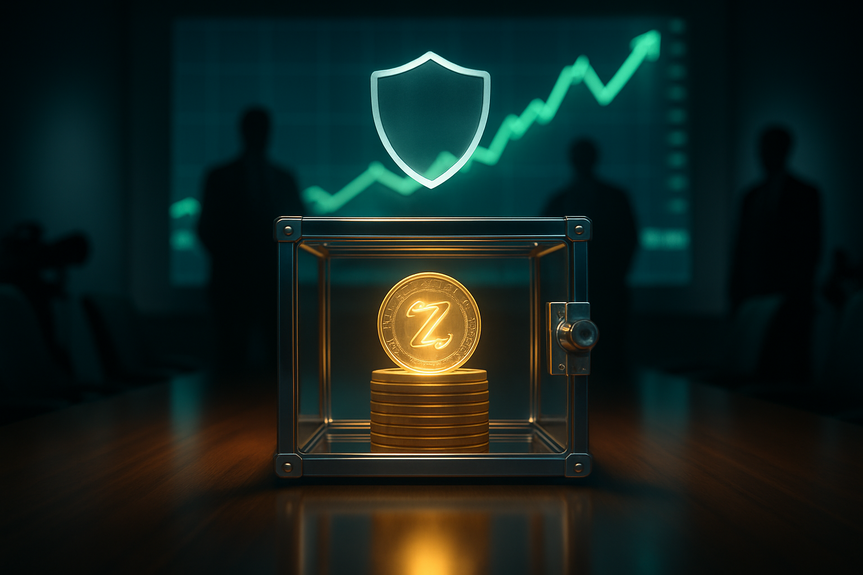Winklevoss-backed Cypherpunk Zcash investment 2025 aims to secure 5% supply and boost ZEC adoption.
Tyler Winklevoss is steering a public company toward Zcash with a large, long-term bet. The Winklevoss-backed Cypherpunk Zcash investment 2025 pairs a $58.9 million capital infusion with a plan to accumulate at least 5% of ZEC’s supply. The move reframes Zcash as “digital cash” beside bitcoin’s “digital gold” story.
Gemini co-founder Tyler Winklevoss has backed a major pivot. Leap Therapeutics now trades as Cypherpunk Technologies on Nasdaq under ticker CYPH, with a fresh $58.9 million from Winklevoss Capital and a clear mission: acquire and hold Zcash (ZEC). The company says it already bought 203,775 ZEC at about $245 per coin, around $50 million total. It aims to hold at least 5% of Zcash’s total supply over time. With about 16.3 million ZEC in circulation today and a hard cap of 21 million, that is a bold target. It invites comparisons to earlier corporate bitcoin treasuries, but with a strong privacy focus.
Winklevoss argues that privacy protects freedom in a digital world. He calls Zcash “encrypted bitcoin” and sees it as a natural pair to BTC. If bitcoin is digital gold, Zcash can act like digital cash. ZEC rallied hard in recent weeks, topping $720 before pulling back to around $460. This surge shows interest, but it also shows risk. Prices can move fast in both directions.
Alongside the rebrand, Cypherpunk appointed Khing Oei as board chair and Will McEvoy as CIO. Douglas Onsi remains CEO. The old Leap Therapeutics cancer-drug work continues inside a wholly owned subsidiary that keeps the Leap name. This structure lets Cypherpunk focus on crypto assets while the biotech research goes on.
Why the Winklevoss-backed Cypherpunk Zcash investment 2025 matters
A new corporate treasury play, focused on privacy
This move shifts the playbook for public companies. In the past, firms like MicroStrategy made headlines by holding bitcoin on their balance sheets. Cypherpunk is doing something similar, but with Zcash. The company is not just trading. It wants to own and hold a large piece of the network. That sends a signal to markets and to builders. It says privacy money has a place in public markets.
From biotech to blockchain: a rare pivot
The change is also unusual. It is not common for a public biotech to rebrand and focus on a crypto asset. By keeping Leap’s drug research inside a subsidiary, Cypherpunk can run two tracks: science under the Leap label and digital asset strategy under Cypherpunk. Investors get exposure to both, but the flagship story is now crypto, not cancer drugs.
The numbers behind the bet
How much is 5% of Zcash?
Zcash has a fixed maximum supply of 21 million coins, like bitcoin. Five percent of 21 million is 1.05 million ZEC. Cypherpunk already holds 203,775 ZEC. That is about one-fifth of the way to 1.05 million. The company bought at an average price near $245. At that entry, the initial lot cost around $50 million. The total $58.9 million treasury seed leaves some room for more buying, but reaching 5% would likely require more capital, future profits, other financing, or opportunistic accumulation over time.
Liquidity, execution, and market impact
Buying that much ZEC is not easy. ZEC liquidity exists, but it is not as deep as bitcoin’s. Large purchases can move price. Execution will matter. The company can:
Split buys across venues and time to reduce slippage.
Use over-the-counter (OTC) desks for blocks.
Build positions during pullbacks instead of breakouts.
Stake its reputation on clear, steady disclosures.
The intent to own 5% can also influence price expectations. Traders may front-run buys. Sellers may raise asks. That can lift price during accumulation. It can also cause sharp drops if the market doubts the plan or if the company pauses buying.
Key figures at a glance
Seed capital: $58.9 million from Winklevoss Capital.
Initial purchase: 203,775 ZEC at about $245 each (~$50 million).
Target: at least 5% of total ZEC supply (1.05 million coins).
Supply model: 21 million max, ~16.3 million circulating now.
Ticker: CYPH on Nasdaq.
What makes Zcash different?
Shielded transactions and zk-SNARKs
Zcash supports two types of addresses: transparent and shielded. Transparent addresses work like bitcoin. Shielded addresses hide sender, receiver, and amount. Zcash uses zk-SNARKs, a form of zero-knowledge proofs, to make this possible. In simple words, you can prove a transaction is valid without revealing its details.
Privacy by choice
Not every Zcash transaction is private. Many users still use transparent addresses, often due to exchange support and tool familiarity. But the shielded option exists, and usage can grow as wallets improve and as more services support shielded transactions. This gives Zcash flexibility. It can play in regulated markets while still offering strong privacy tools for people who need them.
How it compares to bitcoin and Monero
Bitcoin is great for security and decentralization. It does not hide transaction details by design. Monero makes privacy the default using ring signatures and other methods. Zcash takes a different path. It uses advanced cryptography to hide details in a compact proof. Eli Ben-Sasson, a Zcash co-founder and StarkWare CEO, says this approach solves privacy and scalability issues together. He contrasts it with mix-based methods that can leak patterns. This is why some call Zcash “encrypted bitcoin.” It tries to pair bitcoin’s hard-cap ethos with private transfers.
Market reaction and price context
A fast rally shows both interest and risk
ZEC spiked to a seven-year high above $720 before dropping to about $460. That intraday swing is large. It shows how a new narrative can move price. It also shows how thin liquidity can cut both ways. Buyers can push price up quickly. Sellers can pull it back just as fast. Anyone tracking this story should plan for high volatility.
What could drive the next leg?
More accumulation disclosures by Cypherpunk.
New exchange support for shielded addresses or better wallet UX.
Clearer regulation that allows privacy coins on mainstream platforms.
Partnerships that bring Zcash into payment or remittance flows.
Upgrades that improve speed, fees, or privacy defaults.
Corporate treasury strategy: echoes and differences
Echoes of MicroStrategy, but with privacy
MicroStrategy showed how a public company can use a digital asset as its core treasury reserve. Cypherpunk uses a similar playbook, but with a smaller asset and a different value proposition. Bitcoin is about store of value and network effects. Zcash is about private payments and cryptographic assurance. That shift raises potential upside if privacy demand grows. It also raises risk because ZEC is less liquid and more controversial in some jurisdictions.
People and governance matter
Leadership signals intent. Tyler Winklevoss brings crypto credibility and capital. Douglas Onsi leads as CEO with experience from Leap. Khing Oei as board chair and Will McEvoy as CIO add operational and investment oversight. These roles matter. Complex execution, custody, and disclosures all sit on governance. Markets will watch how the team handles treasury policy, risk, and communication.
Risks and what to watch
Regulatory headwinds
Privacy coins have faced pressure. Some exchanges delisted them in certain countries. Rules can change. If regulators restrict ZEC trading, liquidity can suffer. This would raise execution costs and price volatility. It could also reduce institutional access. On the other hand, strong, clear rules could help adoption by giving trusts, funds, and exchanges a compliance path.
Liquidity and custody
Holding a large ZEC position needs robust custody. Firms must manage keys, backups, hardware modules, and policy. They must also plan for shielded address support if they want deeper privacy. Not all custodians support shielded flows today. That can slow treasury moves or force use of transparent addresses, which may lessen privacy.
Technology and roadmap
Zcash relies on cutting-edge cryptography. Upgrades can bring gains, but they can also add risk if bugs appear. The network has a track record of significant improvements, including more efficient proofs. Still, due diligence is crucial. Audits, bug bounties, and careful rollout matter. Investors and companies should watch the development roadmap and community governance.
Who could benefit if the thesis plays out?
Investors and holders
If demand for private payments rises, ZEC could see stronger network use. A well-executed corporate treasury strategy could add credibility and encourage more long-term holding. That can tighten float and influence price, for better or worse.
Builders and wallets
Better wallets that make shielded transactions easy can help adoption. Clear UX, lower fees, and mobile-first designs can bring Zcash into daily use. Grants, hackathons, and app support can turn attention into action.
Exchanges and liquidity providers
If compliance paths for privacy assets improve, exchanges may expand support. Liquidity providers can benefit from wider spreads and deeper volumes. OTC desks can play a central role in absorbing large buys and sells without shocking price.
Scenarios for the next 12 months
Bull case: Cypherpunk steadily accumulates. ZEC gains more exchange and wallet support. Regulation clarifies without harsh bans. Price holds higher lows, and adoption grows in cross-border payments and savings. The “digital cash” story gains traction beside bitcoin’s “digital gold.”
Base case: Cypherpunk buys in stages. Price swings remain wide. Liquidity improves slightly. Regulation is mixed by region. ZEC holds attention, but growth comes in steps, not a straight line.
Bear case: Regulatory pressure rises. Some platforms limit ZEC. Liquidity thins. Price falls back toward pre-rally levels. Cypherpunk slows buys or faces higher execution costs. Adoption stalls.
Signals to track
Public disclosures
Quarterly reports and press releases can show how much ZEC Cypherpunk holds and at what cost basis. This helps markets gauge remaining buying power and conviction.
On-chain data
Watch shielded pool usage and transaction counts. Rising shielded activity suggests product-market fit for private transfers.
Ecosystem upgrades
Software releases that cut fees, speed up proofs, or improve wallet UX can change user behavior. Developer momentum is a key health metric.
Regulatory developments
Rule updates in the U.S., EU, and Asia matter. So do enforcement actions and guidance on privacy features, travel rule compliance, and exchange listing standards.
Practical takeaways
Cypherpunk is making a long-term bet, not a quick trade. Pace and execution will define results.
ZEC’s supply cap mirrors bitcoin’s, but its use case centers on privacy. Treat it as a different asset class within crypto.
Volatility is part of the package. Position sizing and time horizons should reflect this.
Regulatory clarity is the swing factor. Policy can unlock or limit adoption.
Technology progress and UX can turn narrative into real-world use.
The Winklevoss-backed Cypherpunk Zcash investment 2025 is a statement about where digital value may be headed. It says that privacy is not a niche, but a core need for money in the internet age. The numbers are ambitious. The risks are real. The upside sits in the open space between bitcoin’s store-of-value role and the world’s growing demand for private, efficient payments. If Cypherpunk executes with care, and if the Zcash ecosystem keeps improving, this bet could shape a new chapter for corporate crypto treasuries.
(Source: https://www.theblock.co/post/378582/winklevoss-backed-cypherpunk-targets-5-zcash-supply-58-million-treasury-seed)
For more news: Click Here
FAQ
Q: What is the Winklevoss-backed Cypherpunk Zcash investment 2025?
A: The Winklevoss-backed Cypherpunk Zcash investment 2025 is a corporate treasury strategy in which Leap Therapeutics rebranded as Cypherpunk Technologies after a $58.9 million investment from Winklevoss Capital to buy and hold Zcash. The company says it will accumulate at least 5% of ZEC’s supply and has already purchased 203,775 ZEC at about $245 per coin.
Q: How much Zcash has Cypherpunk already purchased and at what cost?
A: Cypherpunk has purchased 203,775 ZEC at an average price of roughly $245 per coin, representing about $50 million of the initial $58.9 million capital infusion. That holding is about one-fifth of its stated goal to reach 5% of the 21 million ZEC supply.
Q: What is Cypherpunk’s 5% target and how many ZEC does that equal?
A: Five percent of Zcash’s fixed 21 million maximum supply equals 1.05 million ZEC, and Cypherpunk aims to hold at least that amount over time. With roughly 16.3 million ZEC currently circulating, their initial 203,775 ZEC is about one-fifth of the 5% target.
Q: Why did Cypherpunk rebrand from Leap Therapeutics and will the biotech work continue?
A: The company rebranded to focus on acquiring Zcash after the Winklevoss Capital funding and will trade on Nasdaq under ticker CYPH, while preserving its cancer-drug research in a wholly owned subsidiary that retains the Leap Therapeutics name. Leadership changes include Khing Oei as board chair, Will McEvoy as CIO, and Douglas Onsi remaining CEO.
Q: How does Zcash’s privacy technology work compared to Bitcoin and Monero?
A: Zcash supports transparent and shielded addresses and uses zk-SNARKs, a form of zero-knowledge proofs, to allow transactions to be validated without revealing sender, receiver, or amount. Unlike Bitcoin, which reveals transaction details by design, or Monero, which uses mix-based methods like ring signatures, Zcash offers optional shielded privacy that aims to combine privacy with scalability.
Q: What are the main risks to Cypherpunk’s plan to accumulate 5% of ZEC?
A: Key risks include regulatory headwinds that have led some exchanges to delist privacy coins, thin liquidity that could make large purchases move the market, and custody challenges around managing keys and support for shielded transactions. Technology risks from upgrades and the need for robust governance and clear disclosures are also highlighted in the article.
Q: How might Cypherpunk execute large ZEC purchases without causing excessive market impact?
A: The article notes strategies such as splitting buys across venues and time, using over-the-counter desks for large blocks, building positions during pullbacks, and maintaining clear, steady disclosures to reduce slippage. These execution choices are intended to limit price impact while Cypherpunk pursues its accumulation goal.
Q: What should observers watch to gauge progress of the Winklevoss-backed Cypherpunk Zcash investment 2025?
A: Observers should watch public disclosures such as quarterly reports and press releases to see how much ZEC Cypherpunk holds and at what cost, on-chain metrics like shielded pool usage and transaction counts, ecosystem upgrades that improve wallet UX or proof efficiency, and regulatory developments in major jurisdictions. These signals will indicate accumulation progress, adoption, and potential liquidity or compliance constraints for the Winklevoss-backed Cypherpunk Zcash investment 2025.







